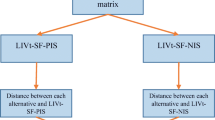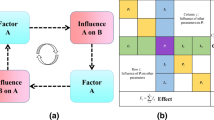Abstract
Curtain grouting efficiency evaluation is vital to ensure the safety and stability of dam foundation constructions. However, the existing grouting efficiency evaluations rarely consider the intrapersonal uncertainty and interpersonal uncertainty involved in the indicator weight determination and cannot objectively reflect the impact of different indicator values on the evaluation results, which may lead to inaccurate results. To address these issues, a variable weight-based interval type-2 fuzzy rough comprehensive evaluation method is proposed. The interval type-2 fuzzy rough AHP is developed to determine the indicator weights under intrapersonal and interpersonal uncertainties, specifically, the individual linguistic judgment is expressed by interval type-2 fuzzy sets (IT2FSs), then the individual judgments are aggregated by rough sets to establish the interval type-2 fuzzy rough number to simultaneously handle individual linguistic vagueness and group preference diversity; furthermore, the multi-attributive border approximation area comparison (MABAC) method extended by variable weight theory is adopted to conduct the grouting efficiency evaluation, and it takes into account the influence of indicator value variations, where the indicator weight can be adjusted according to its actual value to obtain more objective and reliable evaluation results. Finally, the feasibility and superiority of the proposed method are illustrated through a practical case study application and comparisons with several different methods. The proposed model has powerful uncertainty handling capacity and can truly reveal the severity of a problem, ensures more objective and comprehensive evaluation results and is highly practical, which can help grouting engineers judge grouting efficiency more scientifically and effectively.













Similar content being viewed by others
Explore related subjects
Discover the latest articles, news and stories from top researchers in related subjects.References
Li X, Zhong D, Ren B et al (2019) Prediction of curtain grouting efficiency based on ANFIS. Bull Eng Geol Environ 78:281–309. https://doi.org/10.1007/s10064-017-1039-y
Zadhesh J, Rastegar F, Sharifi F et al (2015) Consolidation grouting quality assessment using artificial neural network (ANN). Indian Geotech J 45:136–144. https://doi.org/10.1007/s40098-014-0116-4
Chen M, Lu WB, Zhang WJ et al (2015) An analysis of consolidation grouting effect of bedrock based on its acoustic velocity increase. Rock Mech Rock Eng 48:1259–1274. https://doi.org/10.1007/s0603-014-0624-7
Hernqvist L, Fransson Å, Gustafson G et al (2009) Analyses of the grouting results for a section of the APSE tunnel at Äspö hard rock laboratory. Int J Rock Mech Min Sci 46:439–449. https://doi.org/10.1016/j.ijrmms.2008.02.003
Han Z, Wang C, Zhu H (2015) Research on deep joints and lode extension based on digital borehole camera technology. Polish Marit Res 22:10–14. https://doi.org/10.1515/pomr-2015-0025
Rahmani H, Submitted AT, Partial IN et al (2009) Estimation of grout distribution in a fractured rock by numerical modeling. Vancouver, Canada: The University of British Columbia Master Thesis
Bryson LS, Ortiz R, Leandre J (2014) Effects of a grout curtain on hydraulic and electrical conductivity in a laboratory-scale seepage model. 3233–3242. https://doi.org/10.1061/9780784413272.314
Wang X, Qin Q, Fan C (2017) Research on comprehensive evaluation for grouting effect of broken and soft floor. Arab J Geosci 10:1–7. https://doi.org/10.1007/s12517-017-3198-3
Fan G, Zhong D, Yan F, Yue P (2016) A hybrid fuzzy evaluation method for curtain grouting efficiency assessment based on an AHP method extended by D numbers. Expert Syst Appl 44:289–303. https://doi.org/10.1016/j.eswa.2015.09.006
Zhu Y, Wang X, Deng S et al (2019) Evaluation of curtain grouting efficiency by cloud model – based fuzzy comprehensive evaluation method. KSCE J Civ Eng 23:2852–2866. https://doi.org/10.1007/s12205-019-0519-y
Liu Z, Song W, Cui B et al (2019) A comprehensive evaluation model for curtain grouting efficiency assessment based on prospect theory and interval-valued intuitionistic fuzzy sets extended by improved D numbers. Energies. https://doi.org/10.3390/en12193674
Yang Z, Wang Y (2020) The cloud model based stochastic multi-criteria decision making technology for river health assessment under multiple uncertainties. J Hydrol 581:124437. https://doi.org/10.1016/j.jhydrol.2019.124437
Yang T, Zhang Q, Wan X et al (2020) Comprehensive ecological risk assessment for semi-arid basin based on conceptual model of risk response and improved TOPSIS model-a case study of Wei River Basin. China Sci Total Environ. https://doi.org/10.1016/j.scitotenv.2020.137502
Kayapinar Kaya S, Aycin E (2021) An integrated interval type 2 fuzzy AHP and COPRAS-G methodologies for supplier selection in the era of Industry 4.0. Neural Comput Appl 33:10515–10535. https://doi.org/10.1007/s00521-021-05809-x
Büyüközkan G, Mukul E, Kongar E (2021) Health tourism strategy selection via SWOT analysis and integrated hesitant fuzzy linguistic AHP-MABAC approach. Socioecon Plann Sci. https://doi.org/10.1016/j.seps.2020.100929
Wu Y, Xu C, Ke Y et al (2019) Portfolio selection of distributed energy generation projects considering uncertainty and project interaction under different enterprise strategic scenarios. Appl Energy 236:444–464. https://doi.org/10.1016/j.apenergy.2018.12.009
Dehe B, Bamford D (2015) Development, test and comparison of two Multiple Criteria Decision Analysis (MCDA) models: a case of healthcare infrastructure location. Expert Syst Appl 42:6717–6727. https://doi.org/10.1016/j.eswa.2015.04.059
Moslem S, Gul M, Farooq D et al (2020) An integrated approach of best-worst method (bwm) and triangular fuzzy sets for evaluating driver behavior factors related to road safety. Mathematics. https://doi.org/10.3390/math8030414
De A, Kundu P, Das S, Kar S (2020) A ranking method based on interval type-2 fuzzy sets for multiple attribute group decision making. Soft Comput 24:131–154. https://doi.org/10.1007/s00500-019-04285-9
Kutlu Gündoğdu F, Duleba S, Moslem S, Aydın S (2021) Evaluating public transport service quality using picture fuzzy analytic hierarchy process and linear assignment model. Appl Soft Comput 100:106920. https://doi.org/10.1016/j.asoc.2020.106920
Cheng SH (2018) Autocratic multiattribute group decision making for hotel location selection based on interval-valued intuitionistic fuzzy sets. Inf Sci (Ny) 427:77–87. https://doi.org/10.1016/j.ins.2017.10.018
Sang X, Zhou Y, Yu X (2019) An uncertain possibility-probability information fusion method under interval type-2 fuzzy environment and its application in stock selection. Inf Sci (Ny) 504:546–560. https://doi.org/10.1016/j.ins.2019.07.032
Wang H, Yao J, Zhang X, Zhang Y (2021) An area similarity measure for trapezoidal interval type-2 fuzzy sets and its application to service quality evaluation. Int J Fuzzy Syst. https://doi.org/10.1007/s40815-021-01099-6
Zadeh LA (1975) The concept of a linguistic variable and its application to approximate reasoning-I. Inf Sci (Ny) 8:199–249. https://doi.org/10.1016/0020-0255(75)90036-5
Wu Q, Liu X, Qin J, Zhou L (2021) Multi-criteria group decision-making for portfolio allocation with consensus reaching process under interval type-2 fuzzy environment. Inf Sci (Ny). https://doi.org/10.1016/j.ins.2021.04.096
Wang H, Pan X, Yan J et al (2020) A projection-based regret theory method for multi-attribute decision making under interval type-2 fuzzy sets environment. Inf Sci (Ny) 512:108–122. https://doi.org/10.1016/j.ins.2019.09.041
Qin J, Xi Y, Pedrycz W (2020) Failure mode and effects analysis (FMEA) for risk assessment based on interval type-2 fuzzy evidential reasoning method. Appl Soft Comput J 89:106134. https://doi.org/10.1016/j.asoc.2020.106134
Gölcük İ (2020) An interval type-2 fuzzy reasoning model for digital transformation project risk assessment. Expert Syst Appl. https://doi.org/10.1016/j.eswa.2020.113579
Efe B, Efe ÖF (2021) Quality function deployment based failure mode and effect analysis approach for risk evaluation. Neural Comput Appl 1:10159–10174. https://doi.org/10.1007/s00521-021-05778-1
Chen Z, Ming X, Zhou T, Chang Y (2020) Sustainable supplier selection for smart supply chain considering internal and external uncertainty: an integrated rough-fuzzy approach. Appl Soft Comput J 87:106004. https://doi.org/10.1016/j.asoc.2019.106004
Zhang Z, Chu X (2009) A new integrated decision-making approach for design alternative selection for supporting complex product development. Int J Comput Integr Manuf 22:179–198. https://doi.org/10.1080/09511920802217259
Akay D, Kulak O, Henson B (2011) Conceptual design evaluation using interval type-2 fuzzy information axiom. Comput Ind 62:138–146. https://doi.org/10.1016/j.compind.2010.10.007
Xu Z (2006) A note on linguistic hybrid arithmetic averaging operator in multiple attribute group decision making with linguistic information. Gr Decis Negot 15:593–604. https://doi.org/10.1007/s10726-005-9008-4
Zhu GN, Hu J, Ren H (2020) A fuzzy rough number-based AHP-TOPSIS for design concept evaluation under uncertain environments. Appl Soft Comput J 91:106228. https://doi.org/10.1016/j.asoc.2020.106228
Pawlak Z (1982) Rough sets. Int J Comput Inf Sci 11(5):341–356. https://doi.org/10.1007/BF01001956
Chen Z, Ming X, Zhou T et al (2020) A hybrid framework integrating rough-fuzzy best-worst method to identify and evaluate user activity-oriented service requirement for smart product service system. J Clean Prod. https://doi.org/10.1016/j.jclepro.2020.119954
Deveci M, Özcan E, John R et al (2020) A study on offshore wind farm siting criteria using a novel interval-valued fuzzy-rough based Delphi method. J Environ Manage. https://doi.org/10.1016/j.jenvman.2020.110916
Huang G, Xiao L, Zhang G (2021) Risk evaluation model for failure mode and effect analysis using intuitionistic fuzzy rough number approach. Soft Comput 25:4875–4897. https://doi.org/10.1007/s00500-020-05497-0
Pamučar D, Petrović I, Ćirović G (2018) Modification of the Best-Worst and MABAC methods: a novel approach based on interval-valued fuzzy-rough numbers. Expert Syst Appl 91:89–106. https://doi.org/10.1016/j.eswa.2017.08.042
Pamučar D, Ćirović G (2015) The selection of transport and handling resources in logistics centers using Multi-Attributive Border Approximation area Comparison (MABAC). Expert Syst Appl 42:3016–3028. https://doi.org/10.1016/j.eswa.2014.11.057
Liang W, Zhao G, Wu H, Dai B (2019) Risk assessment of rockburst via an extended MABAC method under fuzzy environment. Tunn Undergr Sp Technol 83:533–544. https://doi.org/10.1016/j.tust.2018.09.037
Dorfeshan Y, Mousavi SM (2020) A novel interval type-2 fuzzy decision model based on two new versions of relative preference relation-based MABAC and WASPAS methods (with an application in aircraft maintenance planning). Neural Comput Appl 32:3367–3385. https://doi.org/10.1007/s00521-019-04184-y
Yazdani M, Pamucar D, Chatterjee P, Chakraborty S (2020) Development of a decision support framework for sustainable freight transport system evaluation using rough numbers. Int J Prod Res 58:4325–4351. https://doi.org/10.1080/00207543.2019.1651945
Wang P (1985) Shadow of fuzzy sets and random sets. Beijing Normal University Press, Beijing
Lin C, Zhang M, Zhou Z et al (2020) A new quantitative method for risk assessment of water inrush in karst tunnels based on variable weight function and improved cloud model. Tunn Undergr Sp Technol 95:103136. https://doi.org/10.1016/j.tust.2019.103136
Zheng G, Wang Y, Li C, Wang X (2020) Real-time quantification of human physiological state in high temperature environments based on variable weight theory. J Therm Biol 89:102531. https://doi.org/10.1016/j.jtherbio.2020.102531
Lugeon M (1933) Barrages et geologic methods de recherché terrasement et un permeabilisation. Litrairedes Universite, Paris
Deere DU (1968) Chapter 1: geological considerations. In: Zienkiewicz OC (ed) Stagg KG Rock mechanics in engineering practice. Wiley, London pp, pp 1–20
Mendel JM, John RI, Liu F (2006) Interval type-2 fuzzy logic systems made simple. IEEE Trans Fuzzy Syst 14:808–821. https://doi.org/10.1109/TFUZZ.2006.879986
Kahraman C, Öztayşi B, Uçal Sari I, Turanoǧlu E (2014) Fuzzy analytic hierarchy process with interval type-2 fuzzy sets. Knowledge-Based Syst 59:48–57. https://doi.org/10.1016/j.knosys.2014.02.001
Song W, Cao J (2017) A rough DEMATEL-based approach for evaluating interaction between requirements of product-service system. Comput Ind Eng 110:353–363. https://doi.org/10.1016/j.cie.2017.06.020
Zhang YZ, Li HX (2006) Variable weighted synthesis inference method for fuzzy reasoning and fuzzy systems. Comput Math with Appl 52:305–322. https://doi.org/10.1016/j.camwa.2006.08.021
Javan HT, Khanlari A, Motamedi O, Mokhtari H (2018) A hybrid advertising media selection model using AHP and fuzzy-based GA decision making. Neural Comput Appl 29:1153–1167. https://doi.org/10.1007/s00521-016-2517-z
Sharma HK, Roy J, Kar S, Prentkovskis O (2018) Multi criteria evaluation framework for prioritizing Indian Railway stations using modified rough AHP-Mabac method. Transp Telecommun 19:113–127. https://doi.org/10.2478/ttj-2018-0010
Jain V, Sangaiah AK, Sakhuja S et al (2018) Supplier selection using fuzzy AHP and TOPSIS: a case study in the Indian automotive industry. Neural Comput Appl 29:555–564. https://doi.org/10.1007/s00521-016-2533-z
Acknowledgements
The authors are grateful to the editor and the reviewers for useful comments and suggestions that helped to improve the paper.
Funding
This work was supported by the National Natural Science Foundation of China [Grant Number: 51839007], National Key R&D Program of China [Grant Number: 2018YFC0406704] and the National Natural Science Foundation of China [Grant Number: 51779169].
Author information
Authors and Affiliations
Contributions
YZ: contributed to methodology, formal analysis and writing—original draft; XW: contributed to conceptualization, resources and supervision; WC: contributed to investigation and writing—review and editing; HG: contributed to writing—review and editing and visualization; DL: contributed to writing—review and editing.
Corresponding author
Ethics declarations
Conflict of interest
The authors declare that they have no conflict of interest.
Additional information
Publisher's Note
Springer Nature remains neutral with regard to jurisdictional claims in published maps and institutional affiliations.
Rights and permissions
About this article
Cite this article
Zhu, Y., Wang, X., Chen, W. et al. A variable weight-based interval type-2 fuzzy rough comprehensive evaluation method for curtain grouting efficiency assessment. Neural Comput & Applic 34, 7851–7879 (2022). https://doi.org/10.1007/s00521-021-06864-0
Received:
Accepted:
Published:
Issue Date:
DOI: https://doi.org/10.1007/s00521-021-06864-0




